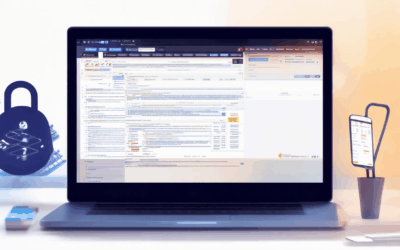In today’s interconnected world, ensuring digital safety for teens has become a paramount concern for parents, educators, and teens themselves. As technology continues to evolve, offering unprecedented access to information and connectivity, it also introduces significant risks that teens may face online. From cyberbullying and privacy breaches to harmful content and predators, the digital landscape presents a complex challenge for young users. This comprehensive guide explores the essential strategies and tools designed to protect teens from these threats, while also emphasizing the critical role of parental guidance and awareness in fostering a safer online environment. By understanding the key components of digital safety and implementing proactive measures, we can help empower teens to navigate the digital world with confidence and security.
Key Takeaways
– Secure Online Accounts: Protect your teens by ensuring they use strong, unique passwords and enable two-factor authentication (2FA) for all accounts. Tools like BlindBrowser can help maintain privacy and security.
– Enable Device Security Features: Activate built-in security tools like Find My Device and use parental control software such as Qustodio or Net Nanny to safeguard devices.
– Monitor Online Behavior: Use family-safe search engines and web filters, limit screen time with apps like OurPetal, and regularly check social media platforms for potential risks.
– Educate and Empower Teens: Hold frequent discussions about online safety, teach teens to recognize scams, and encourage them to report harmful content.
– Stay Involved and Adapt: Regularly review your teen’s online activity, stay updated on emerging threats, and work collaboratively to create a safe digital environment.
– Combine Education, Monitoring, and Communication: Foster a culture of responsibility and awareness by integrating tools like BlindBrowser and maintaining open lines of communication with your teens.

What Does Digital Safety for Teens Involve?
Digital safety for teens encompasses several key components aimed at safeguarding their online activities and personal information. Below is a breakdown of the essential elements:
- Privacy Protection : Educating teens on how to protect their personal information online, such as avoiding sharing passwords or sensitive details, and using privacy settings on their devices and accounts. [1]
- Online Behavior and Cyberbullying : Teaching teens about appropriate online behavior, recognizing signs of cyberbullying, and knowing how to report incidents effectively. [2]
- Screen Time Management : Implementing tools and settings to manage and limit screen time, ensuring healthy digital habits and reducing exposure to harmful content. [3]
- Content Filtering : Utilizing parental control software to filter and block access to inappropriate or harmful content online. [4]
- Media Literacy : Empowering teens with skills to critically evaluate online content, identify misinformation, and make informed decisions about what they consume. [5]
- Community Support : Engaging with local communities or online forums focused on parenting and technology to share experiences and learn effective strategies for digital safety. [6]
By addressing these areas, parents and caregivers can create a safer online environment for teenagers, fostering responsible and confident digital citizens.
[1] BlindBrowser.com provides comprehensive guides on privacy protection.
[2] Understanding cyberbullying statistics and prevention methods is crucial for parents.
[3] Tools like Qustodio help manage screen time effectively.
[4] Net Nanny is a reliable option for content filtering solutions.
[5] Media literacy programs can be found through organizations like Common Sense Media.
[6] Local parenting groups often discuss digital safety tips and best practices.
What Are the Key Components of Digital Safety for Teens?
Digital safety for teens involves a combination of strategies to protect their online activities, ensure their privacy, and foster responsible internet usage. Here are the primary components:
- Online Privacy Protection
- Screen Time Management
- Media Literacy Education
- Cyberbullying Awareness
- Parental Controls and Monitoring
- Community and Peer Support
Teens need to understand and implement measures to safeguard their personal information. Tools like BlindBrowser offer solutions for secure browsing and anonymous surfing, helping teens maintain control over their digital footprint. Educating teens about sharing sensitive data and using strong passwords is crucial.
Excessive screen time can lead to various risks, including cyberbullying and exposure to inappropriate content. Parents should set healthy boundaries and utilize parental control software to monitor and limit screen time effectively. Competitors like Qustodio and Net Nanny provide robust solutions for this purpose.
Empowering teens with media literacy skills helps them discern reliable information from misinformation. This includes understanding algorithms, verifying sources, and recognizing fake news. Schools and parents should collaborate to teach these critical thinking skills.
Recognizing and addressing cyberbullying is essential. Teens should know how to report incidents and seek support. Platforms like StopBullying.gov offer valuable resources for both prevention and response.
Parents play a vital role in monitoring their teen’s online activity. Using tools like FamilyTime allows for real-time monitoring and setting appropriate boundaries, ensuring teens navigate the internet safely.
Fostering a supportive community environment helps teens feel secure and confident. Encouraging open discussions about online experiences and providing access to mentors or counselors can significantly enhance their digital safety.

Why Is Digital Safety Important For Teens?
Digital safety is crucial for teenagers as they navigate the complexities of the online world. Ensuring their well-being and protection requires a proactive approach to safeguarding their personal information, privacy, and emotional health.
- Cyberbullying Prevention: Digital platforms can sometimes be breeding grounds for cyberbullying. By teaching teens how to recognize and report unsafe situations, we can help reduce their risk of falling victim to online harassment.
- Protection From Online Predators: Teens may encounter individuals with malicious intentions online. Implementing measures to monitor and restrict interactions with strangers helps minimize potential dangers.
- Privacy Protection: Adolescents often share personal details online without realizing the risks. Educating them on protecting their private information prevents identity theft and unauthorized access to sensitive data.
- Mental Health Impact: Excessive exposure to harmful content or negative interactions can lead to anxiety, depression, and low self-esteem. Promoting positive online behavior fosters a healthier mental state.
- Access To Harmful Content: Unregulated access to adult content or dangerous communities can have severe consequences. Restricting such material ensures teens are protected from potential harm.
Digital safety isn’t just about technical measures—it involves education, awareness, and open conversations. By prioritizing these efforts, we can create a safer environment for young people to explore and thrive online.
For more resources and tools to enhance digital safety, visit BlindBrowser.com and learn how to stay protected in the online world.

What Are the Essential Steps for Ensuring Digital Safety for Teens?
To safeguard teenagers online, we’ve outlined five crucial steps below:
- Secure Online Accounts :
- Ensure teens use strong, unique passwords for all accounts.
- Enable two-factor authentication (2FA) wherever possible.
- Set up account alerts for suspicious login attempts.
- Enable Device Security Features :
- Activate built-in security features like Find My Device.
- Use parental control software like Qustodio or Net Nanny.
- Regularly update devices to patch vulnerabilities.
- Monitor Online Behavior :
- Use family-safe search engines and web filters.
- Limit screen time through apps like OurPetal or Qustodio.
- Monitor social media platforms for risky interactions.
- Educate and Empower Teens :
- Hold regular discussions about online safety.
- Teach them to recognize scams and phishing attempts.
- Encourage them to report harmful content.
- Stay Involved and Adapt :
- Regularly check their online activity.
- Stay updated on new threats and risks.
- Work together to create a safe digital environment.
For more resources and tools, visit BlindBrowser.com , your trusted partner in online privacy and security.
What Are the Key Components of Digital Safety for Teens?
Digital safety for teens involves a combination of strategies to protect their online activities, ensure their privacy, and foster responsible internet usage. Here are the primary components:
- Online Privacy Protection
- Screen Time Management
- Media Literacy Education
- Cyberbullying Awareness
- Parental Controls and Monitoring
- Community and Peer Support
Teens need to understand and implement measures to safeguard their personal information. Tools like BlindBrowser offer solutions for secure browsing and anonymous surfing, helping teens maintain control over their digital footprint. Educating teens about sharing sensitive data and using strong passwords is crucial.
Excessive screen time can lead to various risks, including cyberbullying and exposure to inappropriate content. Parents should set healthy boundaries and utilize parental control software to monitor and limit screen time effectively. Competitors like Qustodio and Net Nanny provide robust solutions for this purpose.
Empowering teens with media literacy skills helps them discern reliable information from misinformation. This includes understanding algorithms, verifying sources, and recognizing fake news. Schools and parents should collaborate to teach these critical thinking skills.
Recognizing and addressing cyberbullying is essential. Teens should know how to report incidents and seek support. Platforms like StopBullying.gov offer valuable resources for both prevention and response.
Parents play a vital role in monitoring their teen’s online activity. Using tools like FamilyTime allows for real-time monitoring and setting appropriate boundaries, ensuring teens navigate the internet safely.
Fostering a supportive community environment helps teens feel secure and confident. Encouraging open discussions about online experiences and providing access to mentors or counselors can significantly enhance their digital safety.

How Parents Can Help Ensure Their Teens Stay Safe Online
Ensuring your teenager stays safe online requires a multifaceted approach that combines education, monitoring, and open communication. Here’s a guide to help you navigate this complex landscape:
- Set Clear Boundaries and Have Open Conversations
- Use Parental Control Software
- Educate Your Child About Online Privacy
- Encourage Responsible Online Behavior
- Become a Role Model
- Stay Informed and Updated
Start by discussing online safety in a non-threatening manner. Listen to your child’s concerns and experiences to build trust. Explain the importance of privacy and why certain behaviors, like sharing personal information, can be risky.
Install software like Qustodio or Net Nanny to monitor your child’s online activity. These tools can block harmful content and track usage patterns, helping you intervene if needed.
Teach your teenager about password protection, avoiding suspicious links, and recognizing scams. Discuss the long-term consequences of their online actions, such as cyberbullying or sharing inappropriate content.
Establish family rules, like no social media use after bedtime or limiting screen time. Involve your child in creating these rules to foster ownership. Promote offline activities to reduce online exposure and encourage physical interaction.
Parents should lead by example, demonstrating responsible online habits. Show your child how to manage time effectively and handle conflicts online constructively.
Keep abreast of the latest trends and threats by following resources like the National Cyber Security Alliance or the Federal Trade Commission . These organizations provide updated guidelines and tools for online safety.
By combining these strategies, parents can create a supportive environment that encourages safe and responsible online behavior while fostering trust and open communication with their teenagers.




